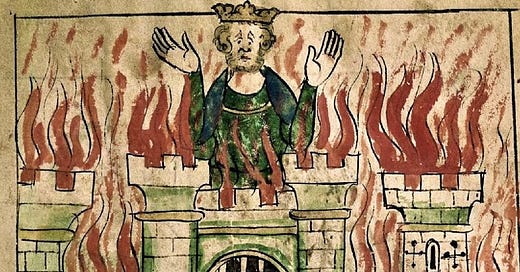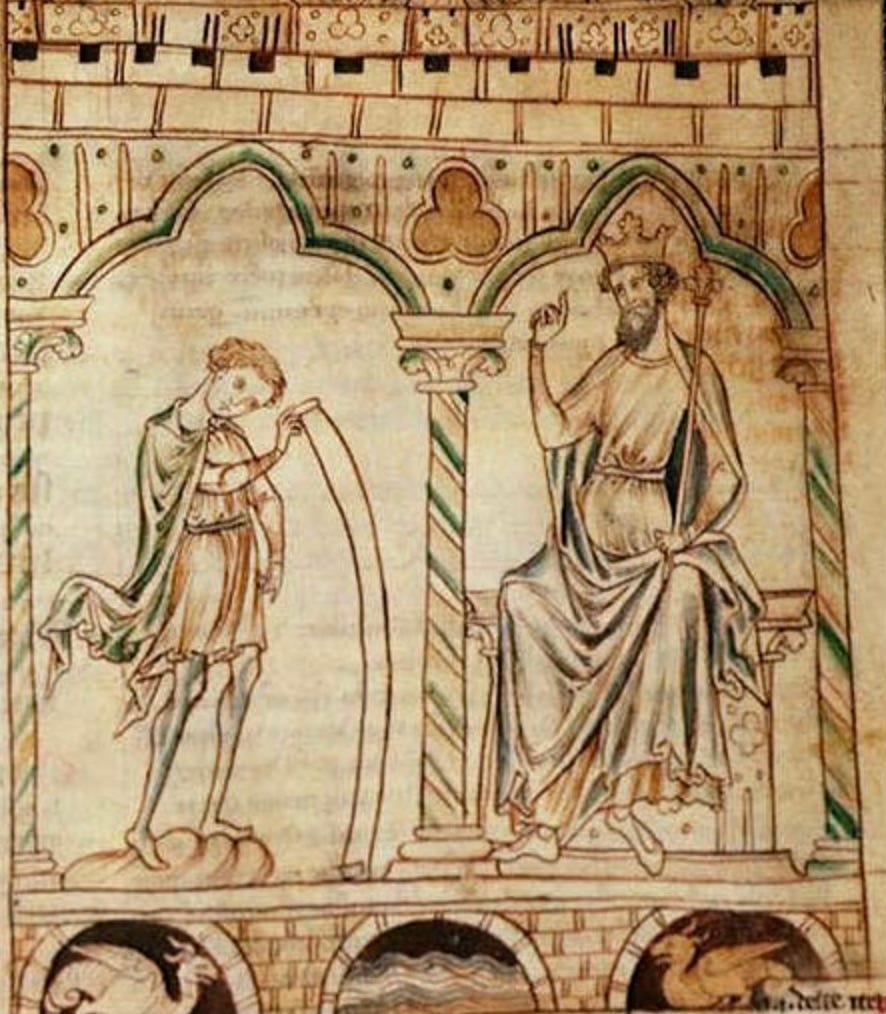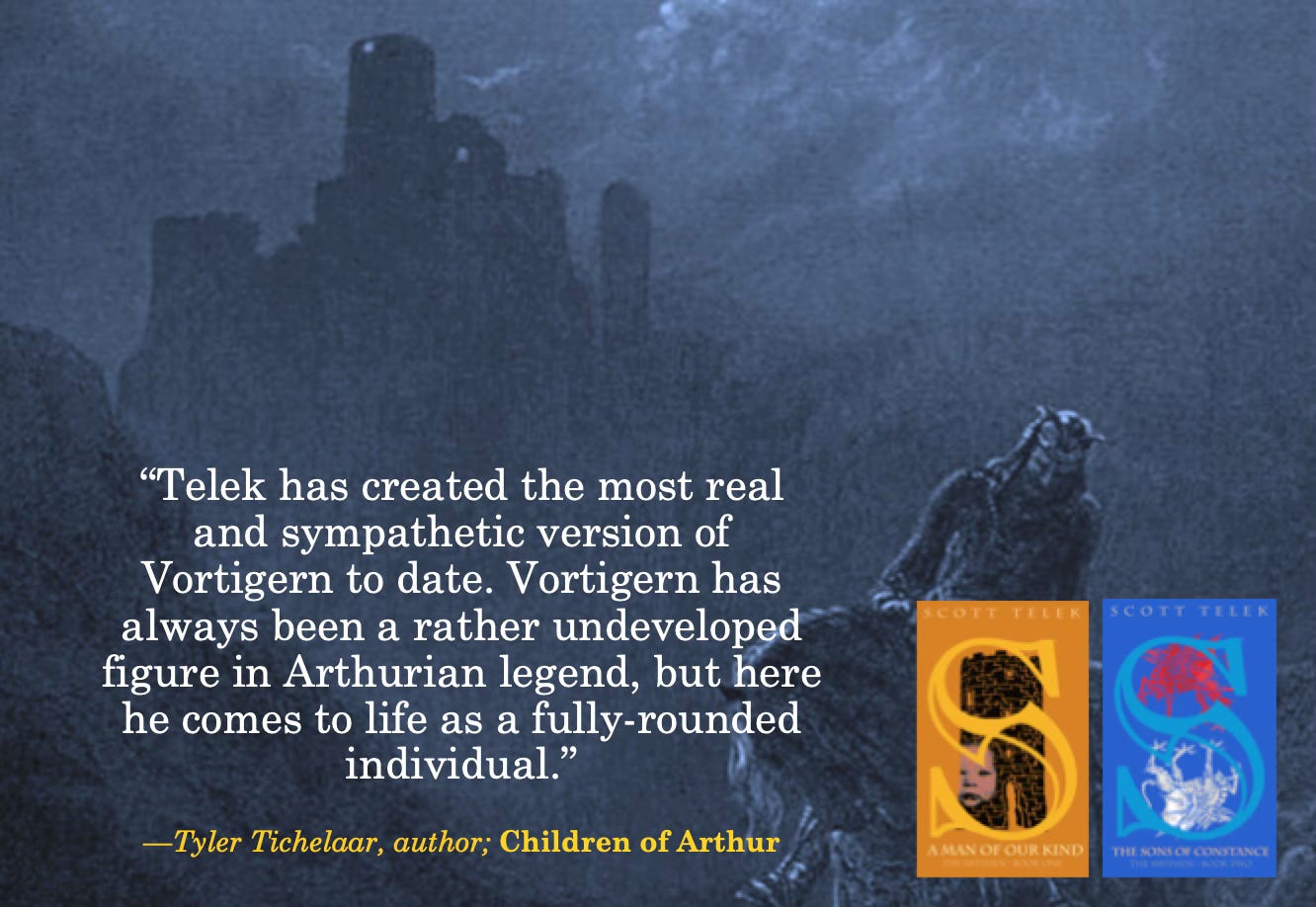Vortigern: Character Brief
Let's take a deep dive into what we know about early Britain's usurper king, the delightfully evil Vortigern.
As the writer of a book series devoted to remaining completely faithful to the Arthurian legends, I need to look at what we know about a character from the medieval sources, then try to flesh out a fully-formed character from that. My challenge is to create a plausible psychology for a character who can believably hit all the plot points from the legend and still seem like a real person. Let’s talk about what all goes into that.
In The Swithen, Vortigern appears in:
Book One: A Man of Our Kind
Book Two: The Sons of Constance
What we know from the legend:
The two main sources used to create Vortigern’s depiction in A Man of Our Kind, Book One were the writings of Wace (1150) and Layamon (1190) who both include story of Vortigern during the period described by this book. The other source was The Story of Merlin from the Vulgate Cycle (1210), which does not include Vortigern’s earlier story (with Hengist and Rowena) but picks up when he needs to build his tower and witnesses the battle between the red and white dragons of Wales (covered in The Sons of Constance, Book Two).
From the legend, we know that Vortigern:
Is suspected to have a hand in arranging the murder of King Constance
Personally pulled Constant from the abbey and put him on the throne knowing he would fail
Arranges for King Constant to assign more and more power and money to him
Allied with the Picts to kill Constant, then blamed them for the murder
Allied with the Saxons in order to save him from the Picts
Married Pagan Rowena, horrifying his Christian countryfolk
Has no particular adherence to any one religion
Allowed Hengist to take the region of Kent without telling the governor of Kent
Was turned against by his own son
Is repeatedly tricked and lied to by Hengist
Was restored to rule after his son was killed
Is hated by his own people
Believes that a strong tower will protect him from his enemies
Believed that a fatherless child’s blood would bond the bricks of his tower
Is told by Merlin that he will die for his crimes
Is killed by the very people he has lived in fear of
Vortigern’s character
The first thing we know for sure is that Vortigern could kindly be described as a schemer. The question comes down to how brilliant and premeditated he is, or how much is he just winging it?
Vortigern schemes for its own sake
There’s no reason to think he did not arrange with the Picts to kill Constance, and we know he manipulates them into killing Constant. He pulled Constant out of the abbey and then manipulated him to assign more power and money to himself. He has the Picts kill Constant, but then he needs to get rid of the Picts. He makes a deal with the Saxons, but that seems impulsive, as though he’s grasping at straws, and he soon finds himself over his head in his dealings with the Saxons.
I came to think that Vortigern was just a very intelligent narcissist who schemed almost for his own amusement than for any grand plan that he had. He seems to plan to be king just because it is the next thing to do rather than from any great yearning for power. Once he attains the role of king, he almost seems to lose interest and grow listless. He certainly entered recklessly into an agreement with the Picts and then even more recklessly into a partnership with the Saxons. It seems he was fairly focused on becoming King, but had no plan for what to do once he achieved it.
Vortigern is a bit of a fool
It seems fairly clear that Hengist runs rings around Vortigern. Hengist is truly cunning and ruthless, and somehow Vortigern never thinks to act defensively or take caution against being tricked. On the other hand, Vortigern marries pagan Rowena knowing it will cause him great trouble with his Christian people, but does it anyway. He gives away Kent without bothering to tell its governor. Then Hengist uses him as a decoy while the Saxons desert Britain, comes back with hundreds of ships when he promised only a few, and gets Vortigern to gather all the British leaders, only to kill them. Seeming to know that Vortigern has taken all that he will, Hengist then throws him in prison.
So what’s going on? The impression is that Vortigern is not the brightest bulb. This is consistent with the idea that Vortigern has no idea what to do once he has attained the kingship. His thinking seems to go off and this mastermind who maneuvered his way into the highest office now seems to fall for ruses his former self would have spotted a mile away. Another possibility is that, for whatever reason, he is flummoxed by Hengist’s audacity and power and simply has no response. We get no hints of his feelings for Rowena except that she’s beautiful, and we get no hints at all of her feelings for him. Regardless, once Hengist arrives on the scene, Vortigern goes from vicious manipulator to hapless rube pretty quickly.
Vortigern in The Swithen
Unlike many Arthurian characters, Vortigern does a lot, so we are able to extrapolate his character from his actions.
His son Vortimer
One of the main things I chose to build on when fleshing out Vortigern’s character is his relationship with his son, Vortimer. We know that Vortimer leads the British forces against his own father later, which seems like kind of a big deal! So I built on this as a way in to Vortigern’s character and a way to reveal his human side and vulnerabilities.
I added the presence of Vortimer earlier, even though he does not appear in the legend until he is about to go to war on his father. This allows us to see how poor Vortigern is as a father and hear about his dead wife (and how good she was as a mother) as a way to round out Vortigern’s character. Readers who have finished Book One know that Vortigern makes a choice that doesn’t work out as he planned, leading to a lot of naked feelings and blunted love for his lost son in Book Two. None of that is in the actual legend, it was added by me to give Vortigern some psychological depth and make him empathetic… otherwise he is just a blank, evil tyrant.
Rowena and Hengist
The other main way I tried to round out Vortigern’s character is through his relationship with Saxon leader Hengist and his daughter Rowena, who Vortigern ends up marrying. Through the legend, we learn almost nothing about their marriage, except it seems obvious it is another way for Hengist to control Vortigern. Around the time of the marriage, Vortigern’s fearsome days are behind him and he just becomes a fool for Hengist, which seems like just another way Hengist can gain more control over him, but Vortigern is blind to.
Eventually Hengist throws Vortigern in prison and attempts to get as much territory as possible out of him, and once Vortigern finally refuses, Hengist releases him. This leads in to the most well-known part of the story, in which Vortigern attempts to build a tower, leading to his meeting Merlin and the fight between the red and white dragons. The legend contains no end to Vortigern and Rowena’s marriage, so we are left to assume it ended around the time Vortigern was imprisoned.
Broken by prison and his son’s death
Book Two, The Sons of Constance, finds us with a very different Vortigern than the one whose downfall we charted in Book One. There are a lot of major incidents in the legend that I chose to rush through—like Hengist killing all British leaders in one day, for instance—to get Vortigern to the place where he wants to build his tower. When we meet him in Book Two, he is now broken by his years in prison, the reality that he has been made a fool by Hengist, and his own role in his son’s death.
This Vortigern is afraid; in fear of Hengist, the British populace who hates him for what he has done to the country, and the long-promised return of Pendragon and Uther (King Arthur’s future father). In the legend, Vortigern’s tower is built and the next thing you know, he’s dead. I chose to depict his change in his final days as a way to offer a more rounded character than just a simple, superficial “tyrant.” Since Merlin tells him clearly that he will die and there is nothing he can do about it, I chose to depict the final days that are not covered in the legend, and have him show his appreciation for life, while at the same time understanding that he has lost and must die.
I am very grateful that readers have really responded to my depiction of Vortigern and many cite his final days as one of the highlights of the series.







